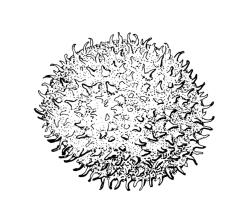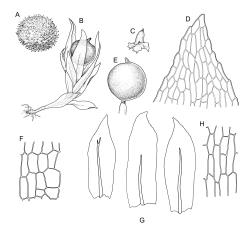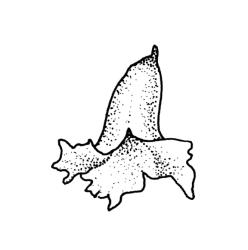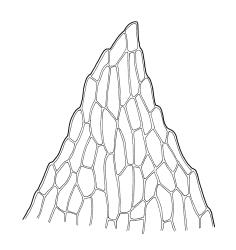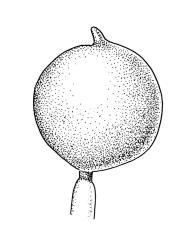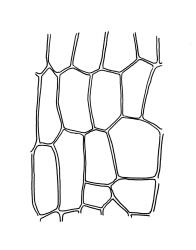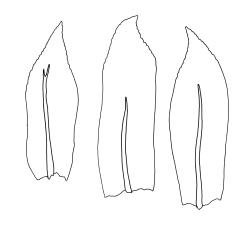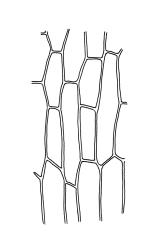Plants very small, gregarious, dark green. Stems 0.5–1.5 mm, red-brown, unbranched, cross-section anatomy not clearly seen, beset near base with smooth, red-brown rhizoids. Leaves incurved around the capsule when dry, spreading when moist, oblong-lanceolate, moderately concave, those of coma c. 1.5 × 0.4–0.5 mm, smaller below (to c. 2 mm in Australian material), acute, margins plane, entire or weakly and bluntly toothed near apex; upper laminal cells oblong-hexagonal, thin-walled, mostly 39–60 × 18–27 µm (some more irregular), becoming larger and more oblong near leaf base, and more compact near apex; marginal cells not differentiated; alar cells slightly inflated but not distinct; costa ½ to ¾ the leaf length, red-brown, mostly unbranched but sometimes weakly bifurcate, in cross-section atypical of the family and lacking stereids. Axillary hairs not seen.
Sexuality uncertain. Perichaetia terminal. Perigonia not differentiated. Setae dark, c. 100 µm (vaginula c. 300 µm long); capsule erect, globose, inoperculate, disintegrating irregularly, 400–500 µm diam. (excluding rostrum), stoutly rostrate, lacking an obvious air space beneath the exothecium, dark red at maturity due to the colour of the enclosed spores, with columella absent at maturity; rostrum straight or oblique, longer than wide, c. 150–200 × c. 50 µm; exothecial cells very thin-walled, oblong-hexagonal, hyaline, at mid urn mostly c. 60 × 30 µm; stomata few and obscure, single-celled, restricted to base of the capsule. Calyptra minute, neither clearly mitrate nor cucullate, c. 0.4 mm, lobed at base covering only the rostrum. Spores spherical to slightly tetragonal, red-brown, uniformly spinose, 30–39 µm diam., a few with weak trilete scars.
Roth 1910–1911, pl. XXI, fig. 4 (as Ephemerella readeri, from type specimen); Roth 1914, pl. X, fig. 4 (as Physcomitrella austro-patens); Scott & Stone 1976, pl. 48 (as Physcomitrella readeri); Catcheside 1980, fig. 136 (as Physcomitrella readeri). The illustrations of Hooper et al. 2010 (figs 4–5, as Physcomitrella readeri) may or may not represent this species.
Physcomitridium readeri, while difficult to detect due to its minute size, is recognisable regionally by its minute, globose, inoperculate, and red-brown capsules. The enclosed spores, rather than the very delicate exothecium, provide the colour of the mature capsules. Because of the fragility of the exothecial cells, the capsule walls often fragment irregularly, leaving a mass of red-brown spores only partially contained in the fragmentary capsule. The laminal cells are lax, smooth, and thin-walled.
There are several species that could be confused with P. readeri. The pottiaceous Acaulon integrifolium has similar immersed and globose inoperculate capsules. It grows on drier sites, has firmer-walled and smaller laminal cells, and usually percurrent to slightly excurrent costae.
Physcomitridium readeri is superficially similar to and sometimes grows intermixed with Physcomitrium pusillum. The lack of a differentiated operculum and its delicate exothecial cells, its fewer and more obscure stomata, smaller spores, and obscure sexuality serve to differentiate the present species. Physcomitrium pusillum, by contrast, has a differentiated operculum, somewhat collenchymatous exothecial cells, more numerous and weakly immersed stomata, and larger spores, and is demonstrably autoicous. The more widespread Bryobeckettia bartlettii can also grow mixed with Physcomitridium. However, B. bartlettii has exserted and ellipsoid capsules with a distinct neck and numerous weakly immersed stomata, and is usually demonstrably autoicous. Both Physcomitrium pusillum and Bryobeckettia bartlettii grew with Physcomitridium at the Waikato River site.
NI: N Auckland (Lower Huia Dam in the Waitakere Ranges), S Auckland (near the confluence of the Whangamarino & Waikato Rivers, Meremere, near Kōpuku).
Australasian. Mainland Australia (Vic.*, N.S.W.*). Reported from Tasmania by Fife & Seppelt (2001, as Physcomitrella patens subsp. readeri). Reported as Physcomitrella readeri from the "silt by the Murray River and edges of billabongs" in S.A. by Catcheside (1980), while Scott & Stone (1976) considered P. readeri occurred in "S.A., Vic., and probably other states". Also reported as a possible adventive in Britain by Hooper et al. (2010), but their claims of occurrence there are beyond the ambit of this Flora. Their suggestion (p. 260) that the present taxon can be "immediately distinguish[ed]" from true Physcomitrella using morphological features is an over-simplification. Because of the afore-mentioned near impossibility of distinguishing Physcomitridium from Physcomitrella Bruch & Schimp. without using genetic markers, all published distribution records of P. readeri should be regarded with caution.
The Waikato River material was all collected from alluvial sandy-silt or clay soil near the river margin and at low elevation. All the collections from this site were made between 1980 and 1983 (the earliest by J.K. Bartlett) and the best documented were made from very near the confluence with the Whangamarino River. There is also one collection (AK 179821) labelled as from "Meremere", which is c. 2 km from this confluence, and one (CHR 351334), from near Kōpuku, some 15 km distant. The single well-developed and ample collection, made by R.O. Gardner, from the Lower Huia Dam, grew on exposed clay in the draw-down zone of a drinking-water reservoir. Associated species at the Waikato River site included Bryobeckettia bartlettii and Physcomitrium pusillum, and, at the Kōpuku site, P. pusillum. No associates were recorded at the Lower Huia Dam site. Physcomitridium readeri is an ephemeral species, and all N.Z. collections were made either in the spring or autumn. Disturbance by invertebrates may play a role in the irregular fragmentation of the capsule exothecium and subsequent spore dispersal.
The material from the Waikato River sites (three or four collections) is morphologically uniform (and as described above). The Waikato River material (including J.K. Bartlett s.n., 17 Mar. 1980, CHR 449103) is clearly the same species as both the type collected by Reader (see below) and Victorian material distributed as H. Inoue’s Bryophyta Selecta Exsiccata 341.
Given the great confusion surrounding this species, it is necessary to be precise about some details of the type collection and publication details of Ephemerella readeri Müll.Hal. and associated names. The protologue states it to be from "Dimboola, Victoria, solo humida, Septembri 1897, Fr. Reader). Nine years later Roth (1910–1911, p. 251) cited the type as from "bei Dimboola" with otherwise identical collection details. Roth (1910–1911) also provided a valuable illustration (pl. XXI, fig. 4) based on the Reader type collection. Apart from this illustration, type material has only been found in the Beckett collection at CHR (626904!). This specimen is labelled "Ephemerella (Physcomitridium) Readeri C.M., sp. nov., Basin of old sheep wash, Upper Region Station, 3/9 1897, leg. F.M. Reader". All the collection data, except the precise locality, agrees with the protologue. Moreover "Upper Region(s) Station" is cited (Wikipedia, accessed 19 July 2017) as an earlier name for the Dimboola area. This specimen is confidently asserted to be original material.
A few years later Roth (1914) published another illustration, as Physcomitrella austro-patens Broth. in Roth (Hedwigia 54: 273, pl. X, fig. 3 a, b, & d). This illustration was based on a second F.M. Reader Victorian collection, made from the Yarra Bay ("Yarraback-Bucht") on 27 Jul. 1902. This collection, not seen, can be taken as the type of Physcomitrella austro-patens, and Roth’s (1914) illustration corroborates Scott & Stone’s (1976, p. 262) suggestion that P. austro-patens is synonymous with Physcomitridium readeri. Scott & Stone are also correct in noting that "New Zealand ‘Physcomitridium readeri’ is not the same species" (see discussion of Bryobeckettia bartlettii, above).
Dixon (1926) discussed Physcomitridium readeri at length, and it is clear that he saw Victorian material. He quoted an opinion by Brotherus that he was inclined to refer it to Physcomitrella s.s. Dixon, however, considered Physcomitridium readeri generically distinct from Physcomitrella based on differences of stomata morphology; he found the stomata in P. readeri to be immersed compared to published illustrations (Limpricht 1885–1889) of those of true Physcomitrella. I have found stomata in the present species to be few in number and difficult to observe and hence cannot corroborate Dixon’s opinion. His observations deserve further study.
Although Tan (1979) studied Victorian material, he did not study type material. He made the combination Physcomitrella patens (Hedw.) Bruch & Schimp. subsp. readeri (Müll.Hal.) B.C.Tan, which is, however, accepted here as a homotypic synonym of both Physcomitridium readeri (Müll. Hal.) G.Roth and its basionym Ephemerella readeri Müll.Hal.
Dixon (1926) also discussed Phascum chiltonii R.Br.bis from the Robert Brown herbarium and collected from the Avon River in Christchurch. Dixon’s observations are confusing as he initially compared the Brown collection favourably to Roth’s illustrations, but then provided a description that seems to be based on material of Bryobeckettia bartlettii (which is well documented and relatively common in the Christchurch area). The type of Phascum chiltonii has not been seen.
Although most of the N.Z. collections of Physcomitridium readeri are more than 30 years old, there is one more recent and well-developed collection from exposed clay in the draw-down zone of a reservoir at Lower Huia Dam in the Waitakere Ranges, N Auckland L.D. (R.O. Gardner s.n., 22 May 2010, CHR 614783) and initially named by J.E. Beever as Physcomitrella patens subsp. readeri. It is confirmed here as Physcomitridium readeri, albeit with reservations. The Lower Huia Dam plants are more yellow-green and softer in appearance than the Waikato plants, with leaves more obovate, considerably wider (to 0.9 mm wide), and apically more obtuse. The margins are entire or bluntly toothed above. Its stem cross-section anatomy is obscure, with no obvious clear central strand seen. The costae are c. ⅔ the leaf length and in cross-section lack stereids. The capsules here are larger and nearly globose, to 0.9 mm long and to 0.75 mm diam., have an obvious air space underneath the exothecium, and a shorter and stouter apical rostrum (with its length ± equal its width and c. 100 × 100 µm). The characteristic one-celled funariaceous stomata, restricted to the extreme capsule base, are much easier to observe here than in the Waikato material. The spores in the Huia material are slightly smaller (mostly 30–33 µm) than those of the Waikato plants. Some of these observed differences call to mind Dixon’s (1926, p. 192) observations on the stomata of P. readeri and those of true Physcomitrella. The morphological differences (especially the leaf shape and width, stomata, and other capsule features) suggest that the Lower Huia Dam collection may differ from the Waikato collections. The taxonomic difficulties associated with Physcomitridium readeri and taxa closely resembling it cannot be completely resolved here.
Physcomitridium readeri remains one of the most poorly documented moss species in N.Z. The few herbarium specimens are mostly sparse and difficult to study. The species is classified as "national critical" in the Department of Conservation’s New Zealand Threat Classification System (Rolfe et al. 2016). Given its ephemeral appearance on recently exposed or deposited silt/clay, it is likely to remain poorly documented indefinitely. Its particular habitat requirements make it an unlikely candidate for active management and it may be more frequent than records suggest.



